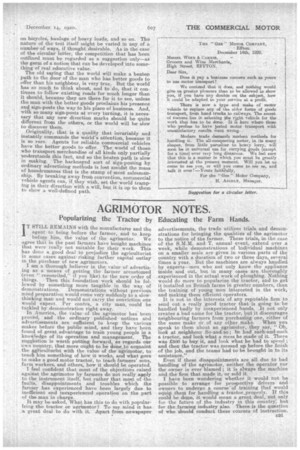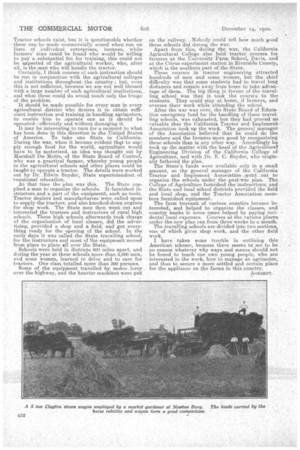AGRIMOTOR NOTES.
Page 25

Page 26

If you've noticed an error in this article please click here to report it so we can fix it.
Popularizing the Tractor by Educating the Farm Hands.
T STILL REMAINS with the manufacturer and the agent to bring 'before the farmer, and to keep before him, the value of the agrimotor. We agree that in the past farmers have bought machines that. were really not suitable for their work. This has done a good deal to prejudice the agriculturist in some cases against risking further capital outlay in the purchase of new agrimotors. I am a thorough believer in the value of advertising as a means of getting the farmer accustomed (even " reconciled," if you like).to the new order of things. Then this foundation work should be followed by something more tangible in the way of demonstrations. Demonstrations without previous mind preparation would come very suddenly to a slowthinking man and would not carry the conviction one would expect. Per .contra, a city man. could be tackled by demonstration right away.
In America, the value of the agrimotor has been proved, and the ordinary published notices and advertisements are sufficient to keep the various makes before the public mind, and they have been found of great advantage to train young people in a knovfledge of its operation and management. The suggestion is worth putting forward, as regards our own 'country, that more Might to be done to acquaint the ogiieulturiat with the value of the .agrimotor, to teach him something of how it works, and what goes to make a good motor tractor, to teach farmers' sons, farm workers, and others, how it should be operated.
I feel confident that most of the objections raised against the agrimotor by farmers do not really apply to the instrument itself, but rather that most of the faults; disappointments and troubles which the farmer has experienced have been largely due to inefficient, and inexperienced operation on the part of the man in charge.
It may be asked, What, has this to do with popularizing the tractor Or agrimotor? To my mind it has a great deal to do with it. Apart from newspaper
advertisements, the trade utilizes trials and demonstrations for bringing the qualities of the agrimotor to the notice of the farmer. These trials, in the case of the S.M.M. and T. annual event, extend over a week, while demonstrations of individual machines on a smaller scale are given in various parts of the country with a duration of two or three days, several times a year. But the machines are always handled by experts—men who not only know the appliance inside and out, but in many cases are thoroughly . experienced in the actual work of ploughing. Nothing would do more to popularize the tractor, and to get it installed on British farms in greater numbers, than the training of young men interested in the work, and making them efficient operators.
It is not in the interests of any reputable firm to send out a really good tractor that is going to be handled badly by inexperienced hands. It not only creates a bad name for the tractor, but it discourages neighbouring farmers from purchasing one, either of the same make or of any other make. When you speak to them about an agrimotor, they say, " Oh, look at neighbour So-and-so ; he had such-and-such a tractor, and look what a mess he made of it. There was £500 to buy it, and look what he had to spend ; and then the tractor was messed up before the finish of the job, and the teams had to be brought in to its assistance."
Even if these disappointments are all due to bad handling of the agrimotor, neither the operator nor the owner is ever blamed ; it is always the machine and, the firm that made it, or sold it. I have been wondering whether it would not be possible to arrange for prospective drivers and owners to undergo a course" of training that would equip them for handling a tractor_properly. If this could he clone, it would mean a great deal, not only for the future of the industry in this country; but for the farming industry also. There is the question of who should. conduct these courses of instruction. Tractor schools exist, but it is questionable whether . these can be made commercially sound when run on lines of individual enterprises, because, while farmers' sons could be found who would be willing to pay a substantial fee for training, this could not be expected of the agricultural worker, who, after all, is the man who will handle the tractor.
Certainly, I think courses of such instruction should be run in conjunction with the agricultural colleges and institutions throughout the country; but, even this is not sufficient, because we are not well blessed with a large number of such agricultural institutions,. and what these could do would touch only the fringe of the problem.
It should be made possible-for every man in every agricultural district who desires it to obtain sufficient instruction and training in handling agrimotors, to enable him to operate one as it should be operated—efficiently and without damaging it.
It may be interesting to turn for a moment to what has been done in this direction in the United States of America. To take one State in California. During the war, when it became evident that to supply enough food for the world, agriculture would have to be motorized, an idea was thought out by Marshall Del Motte, of the State Board of Control, who was a practical farmer, whereby young people in the agricultural schools and other pia-ces could be taught to operate a tractor. The details were worked out by Dr. Edwin Snyder, State superintendent „of vocational education.
At that time the plan was this. The State supplied a.man to organize the schools. It furnished instructors and a part of the equipment, such as tools. Tractor dealers and manufacturers were called upon to supply the tractors, and also knocked-down engines for shop work. The State men then went out and interested the trustees and instructors of rural high, schools. These high schools afterwards took charge of the organization of local classes, did the advertising, provided a shop and a field, and .got everything ready for the opening of the school. In the early days it was called the State travelling school, ,for the instructors and most of the equipment moved from place to place all over the State.
Schools were held in districts 600 miles apart, and during the year at these schools more than 3,000 men, and some women, learned to drive and to care for tractors. One class totalled more than BOO persons. Some of the equipment travelled by motor lorry over the highway, and the heavier machines were put on the railway. 'Nobody could tell how much good these schools did during the war. Apart from this; during the war, 'the California Agricultural College also held tractor courses for farmers at the University Farm School, Davis, and at the Citrus experiment station in Riverside County, which is the southern part of the State. These courses in tractor engineering attracted hundreds of men and some wonien, but the chief difficulty was that some students had to travel long distances and remain away from home to take advantage. of them. The big thing in favour of the travelling school was that it took the courses to the students. They could .stay at home, if farmers, and oversee their work while attending the school.
After the war was over, the State Boaid of Educe; tion emergency fund for the handling of these travelling schools, was exhausted, but they had proved so valuable that the California Tractor and Implement Association took up the work. The general manager of the Association believed that he could do the members-and the farmers More good by reorganizing these schools than in any other way. Accordingly he took up the matter with the head of the Agricultural Engineering Division of the California College of Agriculture, and with Dr. E. C. Snyder, who originally-fathered the plan. The State's funds were available only in a small amount, so the general manager of the California Tractor and Implement Association went out to organize the Eichoois under the post-war plan. The College of Agriculture furnished the instructions, and the State and local school districts provided the field and local shop, and the Tractor Association members furnished equipment.
The farm bureaux of various counties became interested, and. helped to organize the classes,: and country banks in some cases helped by paying incidental local expenses. Courses at the various places under the new plan ran from three weeks to a month.
The travelling schools are divided into two sections, one of which gives shop work, and the other field work.
• I have taken some trouble in outlining this Anierican scheme, because there seems to me to be no _reason whatever why ways and means should not be found to teach our own young people, who are interested in the work, how to manage an agrimotor, and thus to secure a more settled and certain place for the appliance on the farms in this country. AGRIMOT.






























